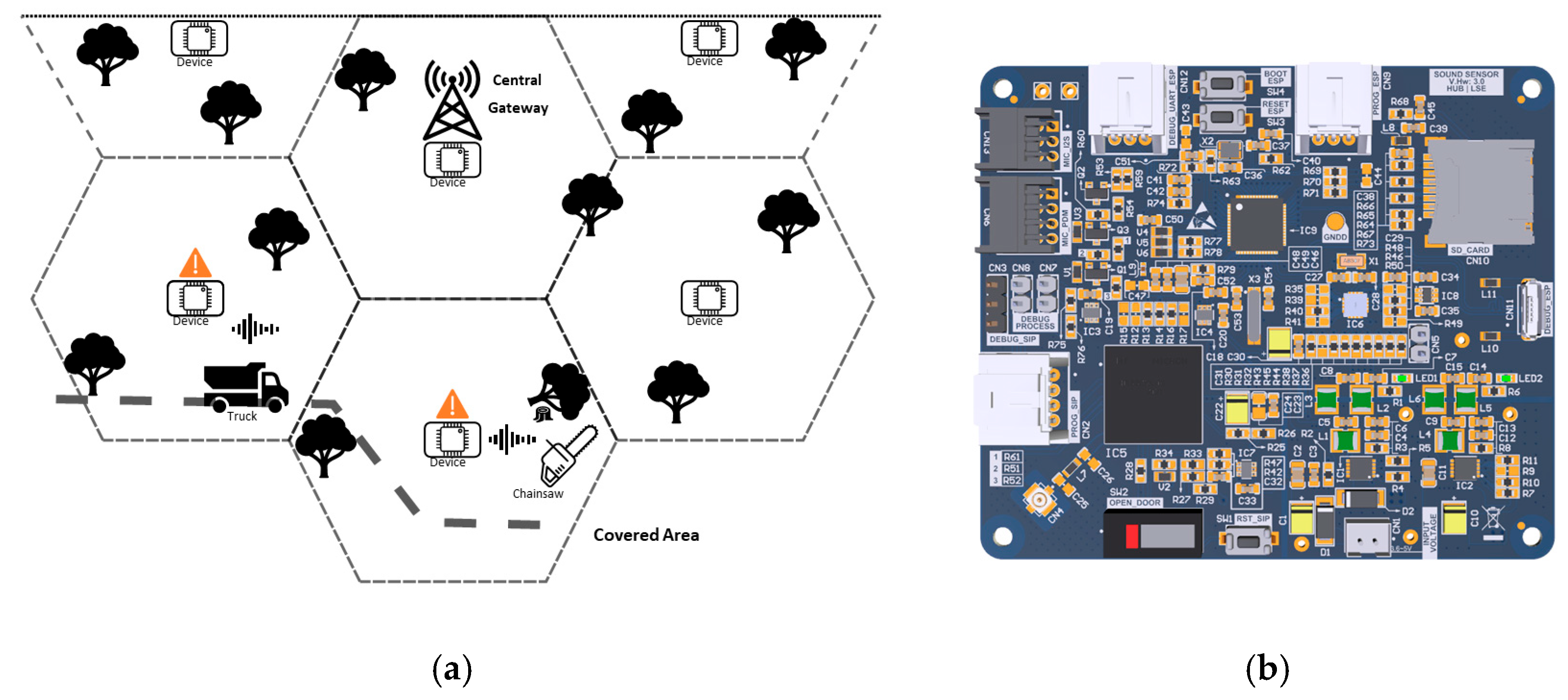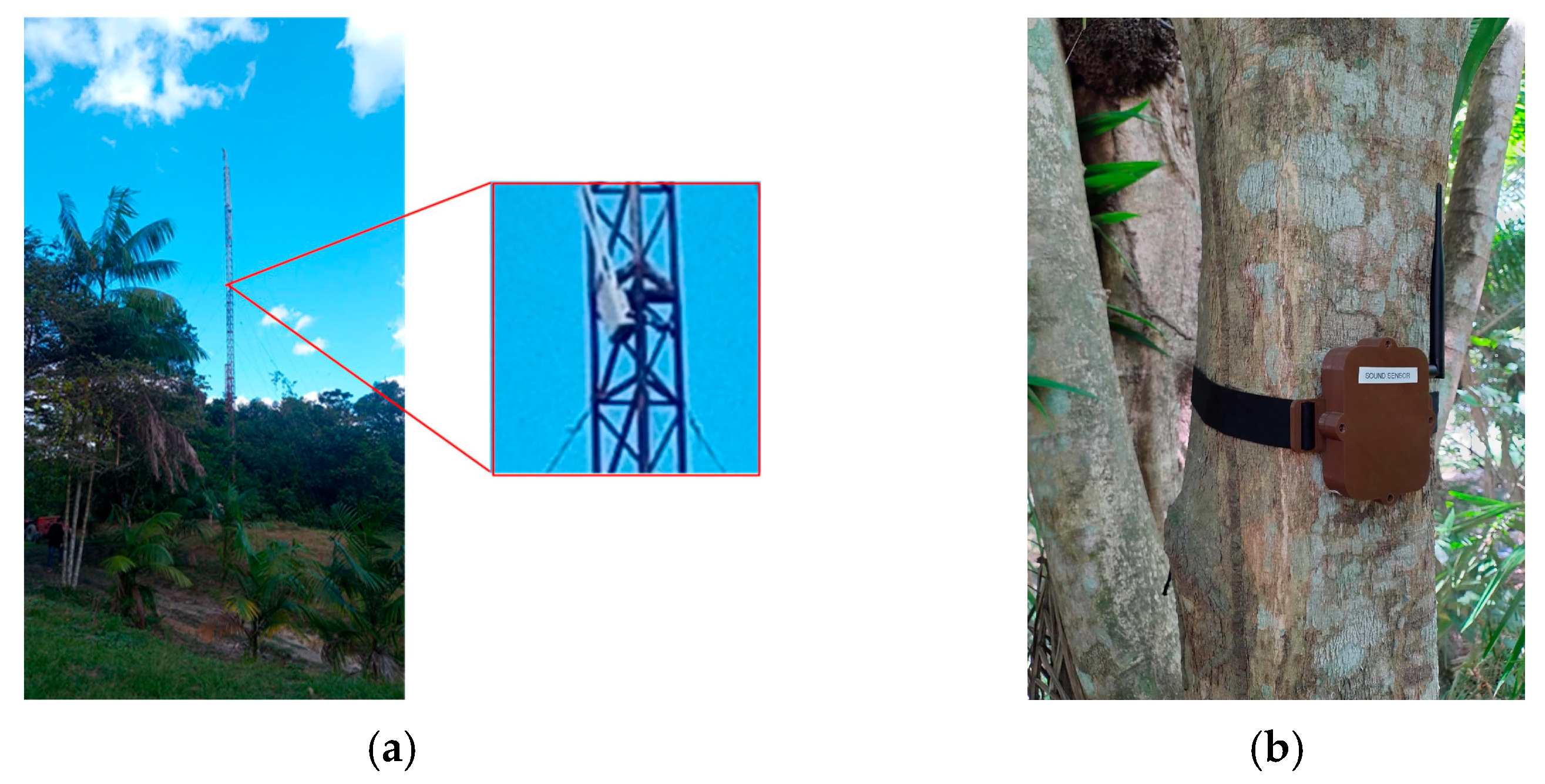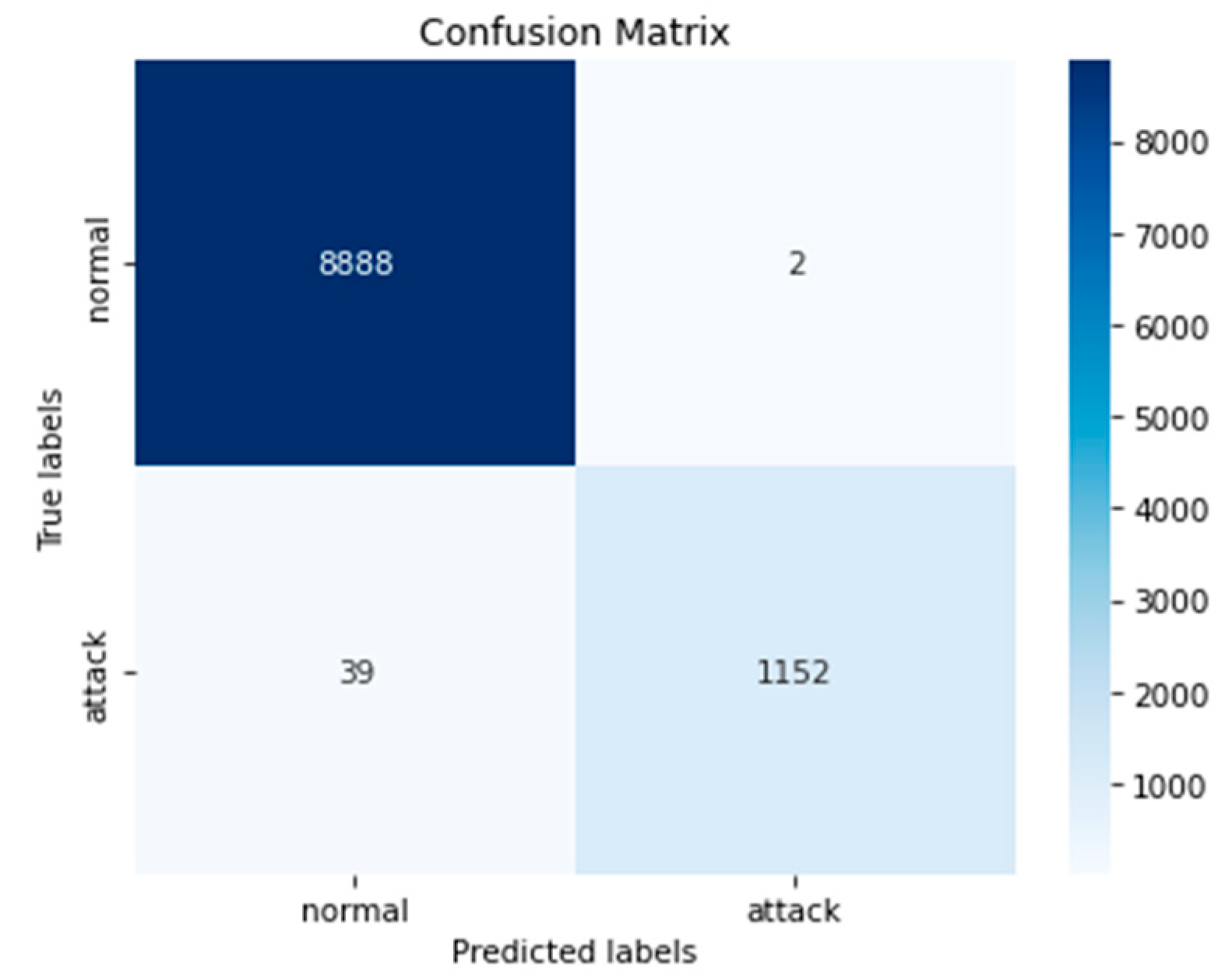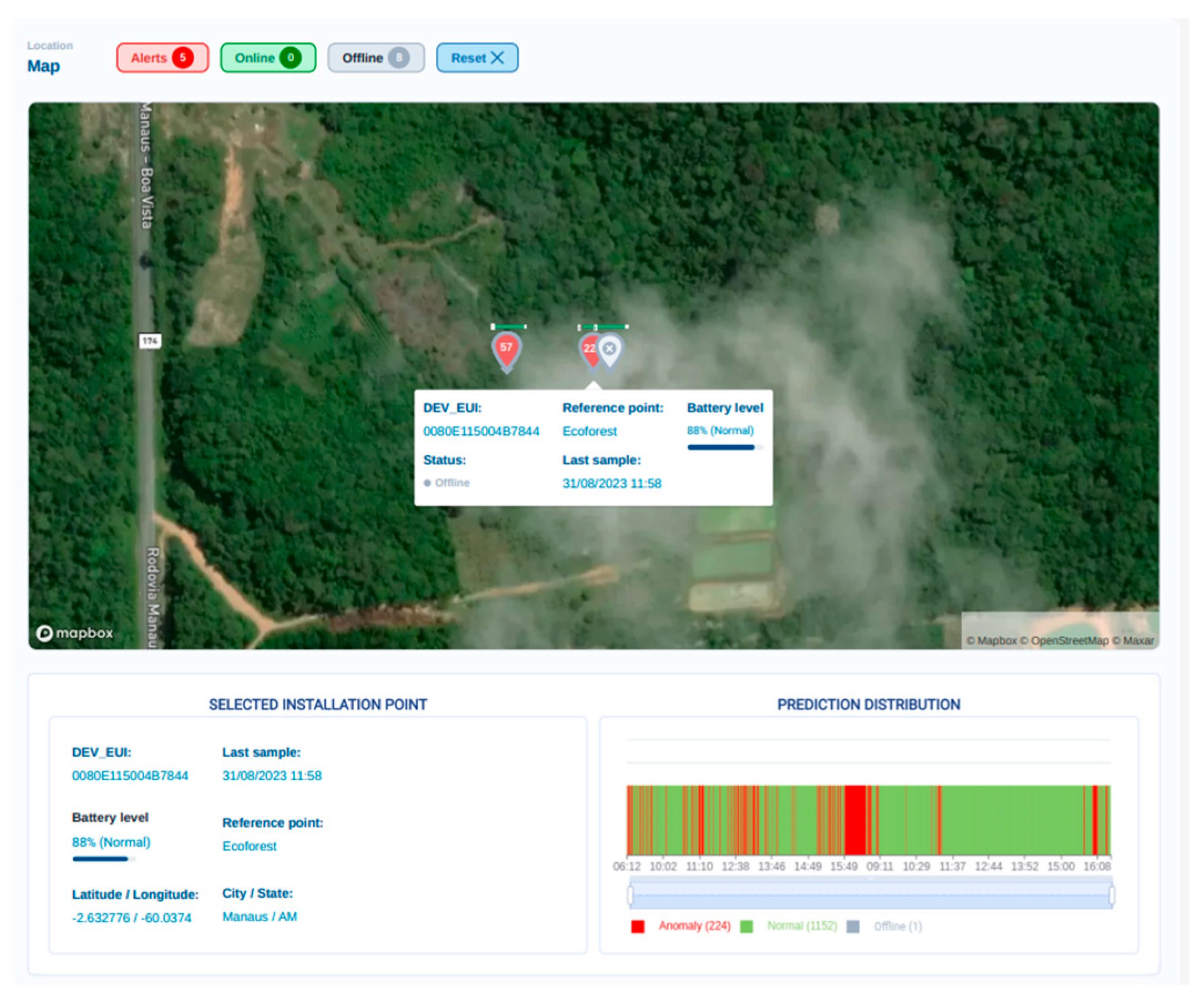1. Introduction
The Amazon Rainforest plays an essential role in climate regulation, capable of controlling precipitation cycles, stabilizing temperatures, and acting as a powerful ‘sponge’, capturing a significant amount of carbon dioxide, the primary gas responsible for exacerbating global warming [
1,
2,
3,
4]. The increasing deforestation in the Amazon Rainforest represents one of the greatest threats to biodiversity, global climate balance, and the communities that depend directly on this ecosystem [
5,
6,
7].
The urgent need to contain and reverse this challenging scenario has driven the development of innovative solutions, among which environmental monitoring devices stand out. In this context, the development of monitoring devices has become a promising strategy for the conservation of the Amazon.
This work aims to present a study on a specific monitoring device that aims to significantly contribute to preventing deforestation in the Amazon Rainforest. The device in question is based on the integration of technologies, including an audio acquisition sensor, LoRa communication networks, and embedded artificial intelligence, in low-power hardware. This information is processed in real time by advanced algorithms capable of detecting patterns and anomalies, providing immediate alerts to the responsible agencies and relevant authorities.
One of the main advantages of this device is its ability to cover vast and hard-to-reach areas, allowing monitoring not only of areas near urban centers but also of remote and border regions. Furthermore, its energy autonomy and real-time data transmission capability make it a valuable tool for making agile and effective decisions.
The environmental impact of this technology is significant because its effectiveness in monitoring the Amazon Rainforest has the potential to deter illegal deforestation activities and, consequently, significantly reduce the rate of forest degradation. However, it is essential to emphasize that the implementation of this device faces challenges, such as the cost of development, operation, and maintenance.
In this context, this work aims to promote a detailed understanding of the proposed monitoring device, and highlighting its benefits and limitations as an important tool for the conservation of the Amazon Rainforest. The discussion on the role of technology in environmental preservation is crucial for guiding policies and practices that promote the sustainability of this ecosystem, which is vital for the planet.
2. Materials and Methods
2.1. Architecture and Hardware Device
The proposed monitoring system should be capable of covering regions of the Amazon Rainforest and identifying deforestation attempts through the acquisition of sounds from trucks and chainsaws. The system has a Central Gateway responsible for the centralized communication of the devices, using LoRa wireless communication.
Figure 1a illustrates the architecture of the monitoring system, with devices installed in the forest region, covering areas with a radius of approximately 1 km between the communication nodes and the Central Gateway.
The developed hardware device consists of an embedded electronic system with the main components being an SD Card module, digital microphones, and microcontrollers. One microphone is responsible for waking up the system from low-power mode and energizing the main systems, while the second microphone) is responsible for collecting audio data for artificial intelligence processing. A microcontroller is dedicated to managing the system’s power and transmitting LoRa packets. Another microcontroller performs embedded artificial intelligence processing.
Figure 1b illustrates the developed electronic board.
2.2. Embedded Artificial Intelligence
To perform the processing of the AI model, the TensorFlow Lite 2.14.0 library was used, which can execute machine learning models on microcontrollers using very few kilobytes of memory. The primary execution environment fits within 16 KB on an Arm Cortex M3 and can run many basic models. The library has been tested on various Arm Cortex-M Series processors and has also been ported to other architectures, including ESP32 [
8].
For the development of an artificial intelligence model capable of identifying deforestation attempts, audio recordings of chainsaws and tractors were initially collected in a forest environment under various conditions, including different motor acceleration levels, and with varying distances between the tools and the audio collection device.
The collected audio data were categorized into two classes: normalcy and deforestation. Subsequently, the audio data were segmented into 1 s samples, each composed of a vector of 16,000 values. After processing the audio, a dataset was obtained, consisting of 50,404 samples. Among these, 88% were categorized as normalcy samples, and 12% as attack samples, indicating deforestation activity.
With the dataset in hand, the training phase proceeded. In this phase, the dataset was split into two subsets: the training set with 80% of the samples and the test set with 20%. It is worth noting that this split was carried out in a stratified manner to ensure representative proportions of both classes in both subsets. The architecture of the neural network consists of 5 one-dimensional convolutional layers, interspersed with pooling layers. Next, a 1D Global Max Pooling layer was applied to reduce the dimensions, and a dropout layer with a rate of 20% was inserted. In the last layer, a fully connected layer was applied using softmax activation. The Nadam optimizer was used, the cost function adopted was categorical cross entropy, and the evaluation metric chosen was the F1-Score. The learning rate was set to 0.001, and a mini-batch containing 256 samples was applied in the training process.
2.3. LoRa Communication and Web Application
The LoRa communication gateway was installed on a 15 m communication tower in the Ecoforest Adventure Park, located in a rural area of the Amazon region. Its purpose is to establish communication with Sound Sensor boards installed in dense forest areas, with a maximum distance of up to 1100 m between them.
Figure 2a shows the LoRa gateway installed on the Ecoforest Adventure telecommunication tower, and
Figure 2b presents the device installed on a tree in the Amazon Rainforest, with its respective protective case and antenna operating at a frequency of 915 MHz and a gain of 5dBi.
To visualize the monitoring data from the Amazon Rainforest processed by each Sound Sensor device, a web application was developed using the frameworks NestJS for creating the Sound Sensor API and ReactJS for creating the project’s web page. The API comprises two databases, PostgreSQL (a relational database) and InfluxDB (a time-series database). It also integrates with ChirpStack, an open-source LoRaWAN server, which registers the Sound Sensor devices and receives their information via uplink.
3. Results
3.1. Energy Management
With the implementation of the device’s operating modes, it was possible to measure the device’s energy consumption at each stage. The average time of operation for each of the modes was also established.
Table 1 presents these measured parameters.
3.2. AI Performance
After the completion of training, it was possible to evaluate the performance of the proposed model. The results and performance metrics achieved on the test dataset are described in
Table 2, and the confusion matrix is shown in
Figure 3.
3.3. LoRa Distance
The maximum message reception distance was validated through a route in the Ecoforest Adventure park. The monitoring device was programmed to send LoRa messages with 1 byte of information in the payload every 10 s during the forest journey, with the geographic coordinates of the location being recorded every 1 min. Simultaneously, the uplinks sent by the device were monitored on the developed dashboard, allowing for the real-time observation of the received data. The coordinates were synchronized with the uplink transmission times in a .csv file. This file was loaded into the Google Earth Pro 7.3.6.9345 software, where it was possible to visualize the traveled path as well as the terrain elevation profile of the forest.
Figure 4 shows the achieved distance of approximately 1023 m from the gateway installation point to the device and the elevation profile of the terrain along the route in Google Earth Pro.
3.4. Data Visualization
Figure 5 depicts the web application developed, where users can view real-time data from the devices, including installation points on a map, battery levels, last sent sample, reference point, latitude and longitude, city/state information, and predictions from the device indicating whether it is in normal operation or in alert mode. This application enables users to take preventive and protective actions for the Amazon Rainforest against deforestation.
4. Conclusions
The illegal deforestation monitoring system for the Amazon involved the development of an embedded electronic device, composed of digital microphones capable of capturing the ambient sounds of the Amazon Rainforest. Through an artificial intelligence model, it identifies the sounds of chainsaws or tractors. The results of this pattern recognition are transmitted via the LoRa network, reaching approximately 1023 m, and can be viewed through a web application. The energy management system achieved ultra-low power consumption, reaching approximately 300 nA of minimum current. The developed neural network was able to accurately identify attacks with an accuracy of 99.6%, with no occurrence of false positives.
In this way, this system has proven to be an efficient means of combating the imminent illegal deforestation of the forest, because it enables the real-time analysis and detection of attacks. It helps maintain biodiversity, the water cycle, and carbon stocks, preserving these natural processes. Furthermore, public policies can be implemented and better managed, even allowing for the recovery of deforested areas. In this sense, this system has the potential to monitor not only the Amazon Rainforest, but also other interconnected ecosystems, promoting environmental preservation in a sustainable manner.
Author Contributions
Conceptualization, R.C.S.G., A.L.P. and I.G.T.; methodology, N.L.V., T.A.T., T.-Y.A.A. and A.G.D.e.D.; software, T.-Y.A.A. and A.G.D.e.D.; validation, N.L.V.; T.A.T., T.-Y.A.A. and A.G.D.e.D.; formal analysis, R.C.S.G. and A.L.P.; investigation, N.L.V., T.A.T., T.-Y.A.A., and A.G.D.e.D.; resources, N.L.V., T.A.T., T.-Y.A.A. and A.G.D.e.D.; data curation, T.-Y.A.A. and A.G.D.e.D.; writing—original draft preparation, N.L.V., T.A.T., T.-Y.A.A. and A.G.D.e.D.; writing—review and editing, R.C.S.G., A.L.P. and I.G.T.; visualization, N.L.V., T.A.T., T.-Y.A.A. and A.G.D.e.D.; supervision, R.C.S.G., A.L.P. and I.G.T.; project administration, R.C.S.G., A.L.P. and I.G.T.; funding acquisition, R.C.S.G., A.L.P. and I.G.T. All authors have read and agreed to the published version of the manuscript.
Funding
This research received no external funding.
Institutional Review Board Statement
Not applicable.
Informed Consent Statement
Not applicable.
Data Availability Statement
The data analyzed during the current study are available from the corresponding author on reasonable request.
Acknowledgments
The authors thank the Embedded Systems Laboratory of the State University of Amazonas for the support provided.
Conflicts of Interest
The authors declare no conflict of interest.
References
- Boulton, C.A.; Lenton, T.M.; Boers, N. Pronounced loss of Amazon rainforest resilience since the early 2000s. Nat. Clim. Chang. 2022, 12, 271–278. [Google Scholar] [CrossRef]
- Lenton, T.M.; Held, H.; Kriegler, E.; Hall, J.W.; Lucht, W.; Rahmstorf, S.; Schellnhuber, H.J. Tipping elements in the Earth’s climate system. Proc. Natl. Acad. Sci. USA 2008, 105, 1786–1793. [Google Scholar] [CrossRef] [PubMed]
- Gatti, L.V.; Basso, L.S.; Miller, J.B.; Gloor, M.; Gatti Domingues, L.; Cassol, H.L.G.; Tejada, G.; Aragão, L.E.O.C.; Nobre, C.; Peters, W.; et al. Amazonia as a carbon source linked to deforestation and climate change. Nature 2021, 595, 388–393. [Google Scholar] [CrossRef]
- Malhi, Y.; Roberts, J.T.; Betts, R.A.; Killeen, T.J.; Li, W.; Nobre, C.A. Climate Change, Deforestation, and the Fate of the Amazon. Science 2008, 319, 169–172. [Google Scholar] [CrossRef]
- Rodrigues, E.; de Almeida, A.B.; Oliveira, A.S.T.; Pacheco, D.L.; Ramos, G.C.; de Sousa, G.O.; de Souza Santos, I.; Bento, J.S.; da Cruz, K.A.S.; Coqueiro, L.F.U. Impactos do desmatamento da floresta Amazônica sobre a saúde pública e as comunidades tradicionais. In Saúde, História, Ciência e Educação: Perspectivas dos Grupos PET da UNIFESP Durante a pandemia de COVID-19, 1st ed.; Fontoura: Várzea Paulista, Brazil, 2022; pp. 75–79. [Google Scholar]
- Castro, D.M.B.; Haonat, A.I. Fiscalização dos Desmatamentos Ilegais na Floresta Amazônica do Brasil: Paralelo a partir do Livro “Vidas Secas”. Rev. Extensão 2021, 5, 50–58. [Google Scholar]
- Fearnside, P.M. Destruição e Conservação da Floresta Amazônica; Editora INPA: Manaus, Brazil, 2022. [Google Scholar]
- TensorFlow for Microcontrollers. Available online: https://www.tensorflow.org/lite/microcontrollers (accessed on 28 September 2023).
| Disclaimer/Publisher’s Note: The statements, opinions and data contained in all publications are solely those of the individual author(s) and contributor(s) and not of MDPI and/or the editor(s). MDPI and/or the editor(s) disclaim responsibility for any injury to people or property resulting from any ideas, methods, instructions or products referred to in the content. |
© 2023 by the authors. Licensee MDPI, Basel, Switzerland. This article is an open access article distributed under the terms and conditions of the Creative Commons Attribution (CC BY) license (https://creativecommons.org/licenses/by/4.0/).













